Content
 The lotus is an amazing flower. From antiquity to the present day, it carries a mystical meaning for peoples professing Buddhism. This is not surprising, the bud can reach from 10 cm to 30 cm in diameter, and the blossoming flower pleases the eye for only 4 days.
The lotus is an amazing flower. From antiquity to the present day, it carries a mystical meaning for peoples professing Buddhism. This is not surprising, the bud can reach from 10 cm to 30 cm in diameter, and the blossoming flower pleases the eye for only 4 days.
He has very delicate petals and a very strong aroma... An essential oil is produced from lotus seeds, which is as expensive as rose oil.
In nature, there are only two species of this beautiful plant: Indian and yellow. Breeders don't stop working over the breeding of new varieties of this flower... And now it has become possible for flower growers and amateurs to grow lotus at home. For this existence of this plant, the constant availability of clean water is necessary and care is very important.
How to grow a lotus?
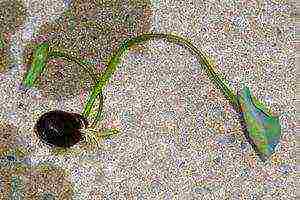 There are two ways to propagate this flower:
There are two ways to propagate this flower:
- root system;
- seeds.
Algorithm for growing a lotus by dividing the rhizome:
- Extract the tuber that has faded from the soil;
- Dry it, make sure it is healthy, there is no powdery mildew and rot on it;
- Cut the tuber into pieces so that one sprout primordium is present;
- Plant in prepared soil covered with water.
Growing this plant in this way has its pros and cons. The plus is that the plant begins to bloom faster and propagation by the root process is quite simple. The downside is that plants obtained in this way are less adaptable to other conditions. Therefore, for those who are just starting to plant lotus at home, it is better to grow it from seeds.
Growing lotus from seeds at home
It includes the preparation of planting material - seeds, a container where seedlings will need to be grown, containers for transplanting a lotus.
Selection and preparation of lotus seeds
 This point should be taken seriously enough. Before buying lotus seeds, carefully study the declared parameters regarding the size of the flower, since the names of the hybrids may coincide, but length of leaves, roots and diameter of buds can be very different. Seeds remain viable for up to 100 years. However, the fresher the seeds are, the better they germinate.
This point should be taken seriously enough. Before buying lotus seeds, carefully study the declared parameters regarding the size of the flower, since the names of the hybrids may coincide, but length of leaves, roots and diameter of buds can be very different. Seeds remain viable for up to 100 years. However, the fresher the seeds are, the better they germinate.
Lotus seeds are dark large oblong nuts, 1.5 cm long, up to 1 cm wide. They are very hard. Therefore, before germination, you need to carry out the scarification procedure. In other words, it means breaking the waterproof shell of the seeds, otherwise the lotus seeds will simply rot.
One side of the seed is pointed and the other is blunt. From the blunt side, you need to open the outer shell so as not to damage the amniotic membrane. A file or sandpaper is suitable for this. The cutting process is a time consuming task.
The prepared planting material is placed in a plastic or glass container. It must be filled with settled water, since chlorinated water is not suitable for germinating lotus seeds. The water temperature should be from +20 to +25 degrees. The water should be changed twice a day. After about 5-7 days, the root and the first sprout will appear from the seed. A characteristic sign that the seeds have swollen and germinate will be their sinking to the bottom of the container. Those seeds that continue to float are likely to have lost their germination.
After 2-3 weeks, the sprouted shoots from the container are transplanted into a large container or directly into the reservoir. At the same time, the height of the seedlings reaches about 15 cm.
Landing algorithm
You should take an aquarium or a plastic pot without holes in the bottom, or another container with a volume of 10 to 20 liters, fill the bottom with soil. Peat can be used as soil. The sprouts should be planted in it to a depth of 6-8 cm. In this case, it is imperative that the leaves float on the surface of the water. Sprinkle the soil with a thin layer of sand, then a layer of pebbles, fill with water. The ratio of soil to water in the container should be 2: 1. The container is placed in a bright and warm place. And then it all depends on the quality of plant care.
Conditions for keeping lotus
 In vivo lotus grows in tropical climates... Therefore, the temperature regime should be at least +25 and not higher than +30 degrees. The plant is afraid of drafts. Requires a lot of light. High relative humidity is required. Often, to ensure moisture, whole compositions are created when a small fountain is placed in the reservoir where the flower grows to spray the leaves of the plant.
In vivo lotus grows in tropical climates... Therefore, the temperature regime should be at least +25 and not higher than +30 degrees. The plant is afraid of drafts. Requires a lot of light. High relative humidity is required. Often, to ensure moisture, whole compositions are created when a small fountain is placed in the reservoir where the flower grows to spray the leaves of the plant.
The thickness of the soil in the container can be at least 4 cm, and the depth of the water above it is at least 50 cm. For round containers, the sprout is planted directly in the center. If the plant is planned to be transplanted into a pond, then its depth should be at least one and a half meters.
Clean water should be added to the vessel as needed and ensured that the water does not become cloudy. Since it can be a breeding ground for the appearance of pests and the spread of diseases in the plant.
For the winter, the water from the container is partially drained, the bottom is covered with foam or moss so that the lotus does not freeze and die. And they clean it up in a dark place until spring. Until sunny and warm days come.
Lotus flowers, which are grown from seeds, appear in 2-3 years. The older the plant, the larger the buds it gives. While maintaining constant optimal conditions for temperature and illumination, it can bloom all year round.
>
 The lotus is a valuable decorative culture that occupies an important place in world culture and religion. The owners of private plots are engaged in the cultivation of this perennial amphibian shrub to decorate decorative reservoirs. The domestic lotus flower is planted with seeds or tubers and has the same care difficulties as the wild one - inappropriateness to cold weather. Therefore, in the conditions of the Russian Federation, it is not easy to grow it.
The lotus is a valuable decorative culture that occupies an important place in world culture and religion. The owners of private plots are engaged in the cultivation of this perennial amphibian shrub to decorate decorative reservoirs. The domestic lotus flower is planted with seeds or tubers and has the same care difficulties as the wild one - inappropriateness to cold weather. Therefore, in the conditions of the Russian Federation, it is not easy to grow it.
Description of lotus varieties
The flower has been cultivated for so long that it itself has already become part of the religion of Buddhism. In addition to its cultural and decorative value, the lotus has nutritional value. The various parts of the shrub are the basis of exotic dishes. From a botanical point of view, lotuses make up an extensive group of perennial plants of the lotus family. There are only two pure wild species:
- Indian nut-bearing, native to Asia. The growing area also covers the Amur River. Has nut-like seeds.
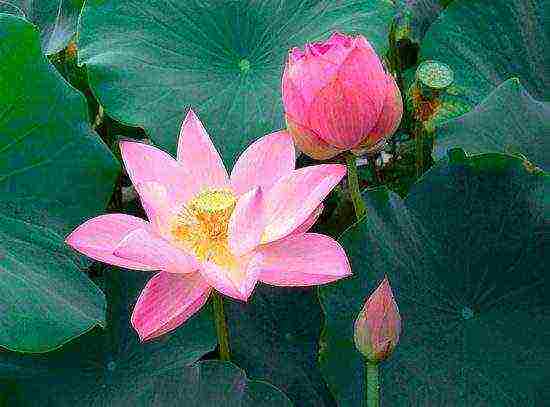
Nut lotus
- Yellow, North American. It has wide emergent leaves, about 70 cm in diameter. The leaves have a shiny waxy coating.
Attention! The decorative plus of the lotus is also the ability to change the position of the flower following the movement of the sun across the sky.
Also, breeders have bred several hybrids. All lotuses have a thick root, which is submerged in the underwater soil and takes out nutrients from there. The stems adapted to the aquatic environment are also completely submerged in the soil. Flexible long deciduous plant petioles stretch to the surface of the water.
There are three types of lotus leaves:
- underwater;
- floating;
- surface.
The flower opens for three days. During this time, some varieties even change the color of the petals. Flowers appear at different points on the leaves.
Height - up to 180 cm, in dwarf species - up to 30 cm. Other features - the shape and length of leaves and flower cups - differ depending on the hybrid. Lotus is extremely heat demanding.For flowers to appear, the plant needs 2-3 months with a stable temperature within + 23 ... + 29 ° С. In colder climates, perennials will not bloom, and in hotter and drier climates, too.
Attention! The peculiarity that became the basis of the mythologization of the lotus in ancient culture is that at night, inside the closed cup of the flower, heat is maintained at about 37 ° C. Therefore, the lotus is so fond of pollinating insects.
How to grow a lotus from seed
Growing at home from seed allows the flower to adapt in a less than suitable climate. Such plants are more resilient to drought or cold snaps. First you need to choose the right planting material. To have a chance of success, you must have tough black nuts with the following parameters:
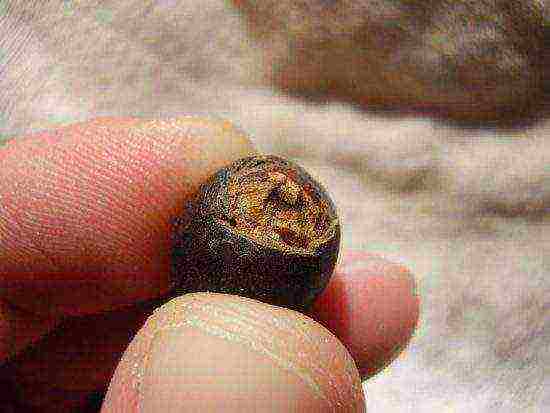
Lotus seeds
- dimensions - approximately 1x1.5 cm;
- pericarp - strong woody.
The seed must first be scarified, filed with coarse sandpaper from a blunt end. Next, find a container - a transparent container: 90-120 cm in diameter, 25-30 cm deep. For dwarf varieties, you can take containers of a smaller volume. Do not use wavy or square containers. Young shoots of the plant can break, leaning against the corner. This will cause significant harm to the lotus.
After that, you can start landing:
- Take a small, shallow jar first. Fill it halfway with warm water (+ 18 ... + 25 ° C).
- Drop the seeds and wait. At room temperature, the first root will appear on the 5-6th day.
- 2-3 weeks after germination, the lotus seeds can be transferred to a large container. Deepen them into the peat 6-7 m. The leaves should remain above the water. To prevent the root tuber from floating up during the procedure, you can press it down with a flat stone.
- Watch out for the growth of the deciduous mass - water must be added regularly so that floating leaves remain exactly on the surface of the water. If the leaves are drowned, the lotus will die.
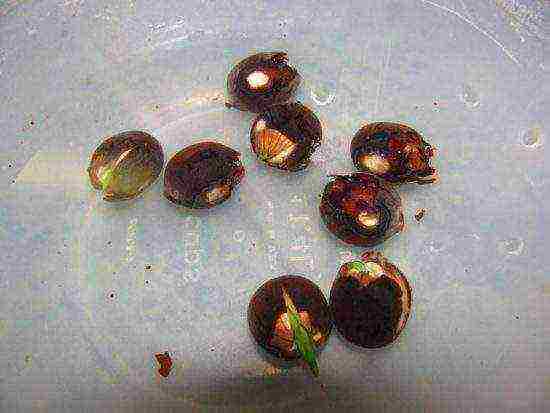
Germinating seeds in water
- The container should be in a sunny and warm place.
- Then the flower can be simply transferred to a summer reservoir or left in the format of a houseplant. The optimal time for final transfer is 5-6 leaves. Previously, a little earth or gravel should be poured over the tuber of the plant.
Features of lotus care
The main thing is to maintain optimal conditions for flower development:
- sufficient water level;
- abundance of the sun;
- temperature not lower than + 20 ° С and not higher than + 29 ° С.
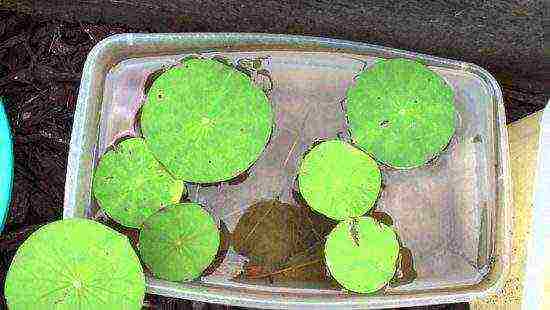
Growing a lotus in a container
Domestic gardeners have gotten used to placing the lotus in ponds directly in containers in order to hide the flower behind home walls with a cold snap and take it out again after the end of the frost. You can also leave the lotus in the pond by simply covering it with foam in the fall. For storage indoors, part of the water must be poured out of the pot, and the plant itself must be insulated with moss.
The pot should be in a cool place. Watering and disturbing the lotus in every way is impossible. Make sure that the temperature in the storage area does not rise in the spring and the plant does not come to life ahead of time. In open reservoirs or large pots for an adult plant, it is enough to observe simple conditions so that the plant does not wither:
- ground level - from 3.5 cm;
- the thickness of the water layer is at least half a meter;
- placing the rhizome in the center of the container.
The lotus is a target for habitual garden dwellers - caterpillars or aphids. Insects can simply be washed off with water. It is important to do this in the morning. You can also use special drugs.
Be prepared that even with perfect care, the flowers will not appear for a long time, and green "pancakes" will simply float above the surface. Lotus owners wait 2-3 years for the first flower. After wilting and dying off of the inflorescence, a seed capsule forms in its place.
Growing a lotus from seeds: video
Lotus is an excellent amphibian and perennial bush type plant. The seeds of the plant have medicinal properties and are used in the creation of numerous decoctions, tinctures, poultices, etc.The European climate with rather harsh winters becomes a kind of obstacle to the normal cultivation of plants in our country. But, in this article we will talk about how to independently, at home, carry out the process of growing a lotus from seeds. Today there are two main ways of growing a plant:
- With the help of the rhizome - the process of division;
- Planting seeds (previously properly germinated and prepared).
Growing lotus seeds at home
This method is ideal for our area, since it is in this way that the aspects of adaptation of the plant to the European area can be ensured. Note that a lotus sprouted from seeds is much more resistant, it perfectly tolerates summer droughts, and even the negative effects of low temperatures.
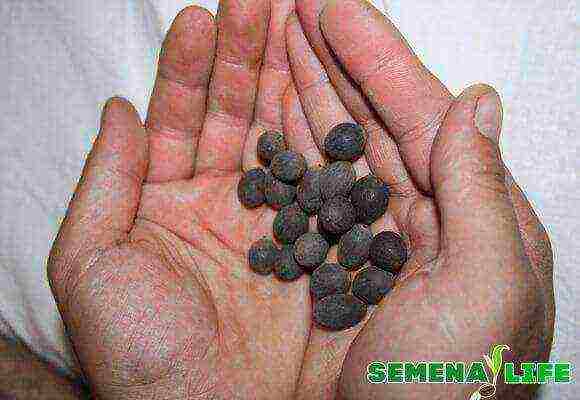
In order for the germination to be correct and of high quality, you need to select the appropriate seeds. Outwardly, they look like nuts (large enough), always black. The coating is very hard, the height is no more than 1.5 cm, and the seed diameter is no more than a centimeter.
In order for the seed to germinate, it must be scarified.
Germination of a plant:
- From the blunt end, where there is a hole in the seed, the hard cover is filed. You can use sandpaper type, which will help to quickly rid the fruit of strong protection;
- After cleaning, you will need to take a sufficiently shallow dish. It is best to use a glass cup, but a plastic cup will work as well. The container is filled with warm water, no more than eighteen degrees;
- The seeds are immersed in warm water, after which, it remains only to wait for the sprouts to "hatch";
- After two to three weeks, a sprouted lotus is formed, it will need to be transplanted;
- The transplant is carried out either in a summer reservoir in the country, or in a regular pot for indoor plants;
- Immediately, earth or peat is poured into the pot, after which the surface is filled with water. Remember that the water must cover the planting soil by at least 10 cm. At the same time, you need to make sure that the leaves of the plant are on the surface;
- The seeds of the plant are deepened by the rhizome seven centimeters into the water (and into the ground), but the leaves must certainly be on the surface, in fact, they must float on the water;
- As the plant grows, you need to add water, make sure that the plant floats on the surface of the water;
- If the sprouts with leaves are drowned, then the plant instantly dies.
Important points of growing lotus
Pay attention to the fact that it is the right care that ensures the rapid development of the plant. After two years, you will already have the first flowers, over time, a box with seeds will form in place of the flower. Water should be added to the plant regularly, while heat and light are the main indicators of growth. Make sure the flower is getting the right amount of sunlight. Consider also that the plant can be taken out into the open air, but only after the end of the frost. Low temperature settings will adversely affect the plant and its development.
An equally important point in the development of a plant is the correct choice of capacity.
The tray grows well in large pots or in pits and open ponds. Experienced experts recommend that the soil layer be at least 3.5 cm for already mature plants, and the water level in this case should be at least half a meter. In the case of planting in a large pot, make sure that the rhizome is directly in the center.

If the lotus is left for the winter in an open reservoir, then it will certainly need to be insulated. In this case, ordinary foam is used, which is used to cover the reservoir, already from late autumn. At home, some of the water will need to be drained from the pot, and moss should be used as the main element of insulation. For the winter period, the plant is placed in a cool, fairly dark place. The most important thing in this case is the absence of abundant watering.In the spring, you need to make sure that the bush does not start active growth, this can damage development, therefore, with the onset of spring, the lotus is gradually "accustomed" to a warm and light atmosphere.
Remember, too, that like most plants, the lotus also has pests.
These can be caterpillars and aphids. In specialized stores, you can purchase products that are used to treat leaves from the negative effects of pests. When using such funds, make sure that the instructions are clearly followed, otherwise you can burn the leaves and destroy the plant.

Experts advise using a special pot structure when planting a plant. The planting mixture is poured onto the bottom, approximately 30-35 cm. On top, small pebbles are applied - no more than 10 cm, and about 10-30 cm of water (water covers the ground and pebbles). This structure of the planting site is optimal. The most important thing is to make sure that the lotus leaves are not completely submerged in water, otherwise this will lead to almost instant death of the plant.
The lotus is rightfully one of the most beautiful amphibian plants, which bloom beautiful white or pink flowers of large size during the flowering period. The southern countries with a hot climate are considered the birthplace of the lotus, but thanks to experienced flower growers and breeders, today anyone who wants to grow this beautiful perennial plant at home, the main thing is to understand how to do it correctly.
The lotus is rightfully one of the most beautiful amphibian plants, which bloom beautiful white or pink flowers of large size during the flowering period. The southern countries with a hot climate are considered the birthplace of the lotus, but thanks to experienced flower growers and breeders, today anyone who wants to grow this beautiful perennial plant at home, the main thing is to understand how to do it correctly.
Types of cultivation
There are two ways to grow a lotus at home: from seeds and by dividing the rhizome. Of course, the fastest and most effective method is division, but to use it, you need to find an adult plant somewhere (for example, in a pond). It will be extremely difficult to get the root on your own and it is not recommended to do this.
But growing a lotus from seeds at home can be quite easy and without any particular difficulties, you just need to follow the rules and sequence.
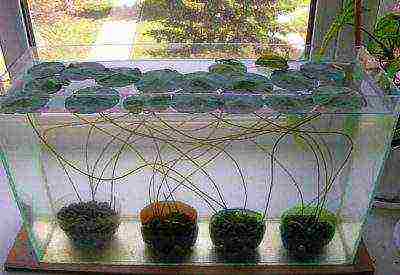
Growing from seeds
Before you start growing, you need to prepare everything you need:
 Clairvoyant Baba Nina named the signs of the zodiac, on which money will fall from the sky in May 2018 ...
Clairvoyant Baba Nina named the signs of the zodiac, on which money will fall from the sky in May 2018 ...
►
- Select seeds.
- Prepare the seeds.
- Find a jar with a volume of 0.5 liters.
- Prepare a container for transplanting.
Since the lotus is an amphibious flower, its root is deep under water, at the very bottom, and the leaves and flowers, on the contrary, are on the surface. To grow a flower at home, you need to create a natural habitat, that is, an artificial reservoir or pond.
At first, a can of water will serve as a good replacement so that you can plant seeds for seedlings. In the future, when the seeds hatch and the sprouts go up, a larger container will be required for comfortable development. It can be a small aquarium, an artificial mini-reservoir in a home area or summer cottage, a small five-liter barrel, or a medium-sized deep flower pot.
Seed selection
When choosing seeds, the first thing you should pay attention to is how large an adult flower grows. You can buy two exactly the same lotus varieties, but one will grow up to 50-60 cm (dwarf lotus), and the other up to 140-180 (regular).
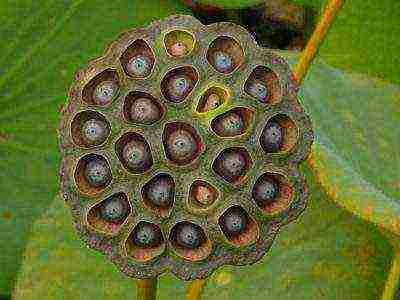
Look carefully at the sorting date and expiry date: fresher seeds germinate much better.
Seed preparation
The seed itself is round and looks more like a nut. To make it easier for the sprout to hatch and start up the roots, it is necessary to carry out scarification.
On any lotus seed there is a place with a small dimple, which is both well felt and visible to the naked eye. Grind this side off with a small file or sandpaper. As a result, you should get the following:
Landing
Now that you have everything you need at hand, you can start planting. To maintain consistency, the entire process will be scheduled step by step.
- 1In a half-liter jar, you need to pour about 400 ml of warm water, 20-25 degrees will be quite enough.
- 2After that, pre-prepared seeds are placed in the jar.
- 3Now you need to wait for the first shoots to appear. This usually happens after 5-7 days.
- 4 After 3–3.5 weeks after planting, the grown sprouts can be transplanted into a larger container, but do not rush.
- 5 In their natural habitat, any body of water or pond has a bottom: sandy, clayey, silty or any other. A similar bottom should be made in a new container. To do this, mix in equal proportions sand, earth and peat, then pour the finished mixture in a layer of 7–8 cm on the bottom of a flowerpot, aquarium or mini-reservoir.
- 6 Then the container must be filled with water to 85-90% and allowed some time for all the sediment to settle.
- 7 You can now transfer. Each sprout is carefully removed from the jar and placed in a new container. After a while, the roots will go deep into the soil and all that remains to be done next is to look after and wait for the lotus to bloom. When transplanting, it is recommended to distribute the sprouts evenly over the entire area of the new container. So it will be more beautiful, and they will not interfere with each other.
Bloom
The first large flowers from the plant can be expected no earlier than in 2-3 years, and until that moment, all the flowers will be small.
The flowering period itself does not last long - 3-5 days, depending on the variety. After that, the petals begin to crumble and only a small box remains, in which the seeds are located. If desired, your favorite flower can be propagated in an already familiar way.
The older the lotus, the larger its flowers. For example, in some plants, a flower in an open state can reach up to 30–35 cm in diameter.
Care
Caring for a lotus is quite simple and should not be a problem even for a beginner. It is important to remember three things:
- 1Water level.
- 2 Lighting.
- 3 Temperature.
Water
The water level must be constantly monitored. The reference point is the upper leaves of the lotus. They should always be on the surface and in no case under water - this must be firmly remembered.
Lighting
Since the lotus is a light-loving plant, it just needs good lighting. If the pot will be placed on the windowsill, then you need to choose the one where there is the most light during the day. In addition, in late spring and summer, the flower can be taken out into the street - there are no problems with lighting, and the air is always fresh.
Temperature conditions
Lotus extremely dislikes cool weather, frost and any cold snap. The optimum temperature for it can be called 20-28 degrees Celsius. Indoors, the lower mark can be safely lowered to +17, but not lower.
Conclusion
As you can see, there is nothing complicated and difficult in growing a lotus from seeds. The main thing is to follow the sequence described above and the rules of care.
And a little about secrets ...
The story of one of our readers Irina Volodina:
Especially depressing for me were the eyes, surrounded by large wrinkles plus dark circles and swelling. How to remove wrinkles and bags under the eyes completely? How to deal with swelling and redness? But nothing makes a person look older or younger than his eyes.
But how to rejuvenate them? Plastic surgery? Recognized - not less than 5 thousand dollars. Hardware procedures - photorejuvenation, gas-liquid pilling, radiolifting, laser facelift? Slightly more affordable - the course costs 1.5-2 thousand dollars. And when to find all this time? And it's still expensive. Especially now.Therefore, for myself, I chose a different way ...
Read the article >>


